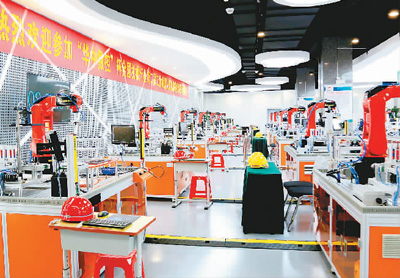

China’s National Development and Reform Commission unveiled the country’s second group of 36 national “characteristic towns” in a recent notice, providing guidance on their development.

Tourists visit the Tang West Market Culture and Tourism Town in Xi’an, northwest China’s Shaanxi province. (Photo provided by the interviewee)
So-called “characteristic towns” do not refer to administrative towns or industrial parks, but an area of a few square kilometers designated for entrepreneurship and innovation, featuring the integration of a certain industry and urban development. In addition, living zones and eco-functional zones should be included so that people can enjoy both living and working there.
Generally, these areas focus on a certain mainstay industry, such as smart manufacturing, press and publication, and tourism.

Liaoning Intelligent Manufacturing Application Demonstration Base in Yongan Machine Tool Town, Shenyang, capital city of Liaoning province. (Photo provided by the interviewee)
One example is a small “tourism town” in Xi’an, northwest China’s Shaanxi province. It’s built on the original site of the West Market of the Tang empire (618-907) in the city of Chang’an (today’s Xi’an), which was the largest trade center in the world at the time.
“The site was the starting point of the Silk Road during the Sui and Tang dynasties,” said Li Zhonghang, CEO of Tang West Market Group, its developer, adding that the scarcity of resources allows the company to fully tap the value of its profound historical and cultural resources.
Featuring the culture of the Tang dynasty during its heyday and Silk Road culture, the “characteristic town” has made culture and tourism its major industries. It currently receives 20 million tourists every year, with an output value of about 3 billion yuan.
The Tang West Market “tourism town” also holds a variety of cultural activities to attract tourists. As China seeks to consolidate positive momentum during the novel coronavirus epidemic, the place has once again become a popular tourist destination.

A view of Taishan Press and Publication Town in Tai 'an, east China’s Shandong province. (Photo provided by the interviewee)
Covering a planning area of 1.5 square kilometers, the place is home to the Tang West Market Museum, a first-class museum in China, a Silk Road cultural street, and antique shops, which combine to bring the Tang dynasty back to life and turn the place into an online sensation.
“Uniformity is a dead-end in the construction of ‘characteristic towns’,” Li said, explaining that from the outset, the company decided to tap the value of Silk Road culture by developing the culture industry based on its historical and cultural heritage.
The second phase of the “tourism town”, which includes office buildings, hotels, and theaters, is under construction, and the third phase will start next year.
Upon completion, it is expected to attract over 10,000 market players and create about 100,000 jobs, generating 500 to 600 million yuan in tax revenue, according to Li.
During the construction of “characteristic towns”, problems such as excessive growth of real estate construction, ecological destruction, and acquisition of farmland for other purposes in violation of laws and regulations should be avoided.
 Fire brigade in Shanghai holds group wedding
Fire brigade in Shanghai holds group wedding Tourists enjoy ice sculptures in Datan Town, north China
Tourists enjoy ice sculptures in Datan Town, north China Sunset scenery of Dayan Pagoda in Xi'an
Sunset scenery of Dayan Pagoda in Xi'an Tourists have fun at scenic spot in Nanlong Town, NW China
Tourists have fun at scenic spot in Nanlong Town, NW China Harbin attracts tourists by making best use of ice in winter
Harbin attracts tourists by making best use of ice in winter In pics: FIS Alpine Ski Women's World Cup Slalom
In pics: FIS Alpine Ski Women's World Cup Slalom Black-necked cranes rest at reservoir in Lhunzhub County, Lhasa
Black-necked cranes rest at reservoir in Lhunzhub County, Lhasa China's FAST telescope will be available to foreign scientists in April
China's FAST telescope will be available to foreign scientists in April "She power" plays indispensable role in poverty alleviation
"She power" plays indispensable role in poverty alleviation Top 10 world news events of People's Daily in 2020
Top 10 world news events of People's Daily in 2020 Top 10 China news events of People's Daily in 2020
Top 10 China news events of People's Daily in 2020 Top 10 media buzzwords of 2020
Top 10 media buzzwords of 2020 Year-ender:10 major tourism stories of 2020
Year-ender:10 major tourism stories of 2020 No interference in Venezuelan issues
No interference in Venezuelan issues
 Biz prepares for trade spat
Biz prepares for trade spat
 Broadcasting Continent
Broadcasting Continent Australia wins Chinese CEOs as US loses
Australia wins Chinese CEOs as US loses